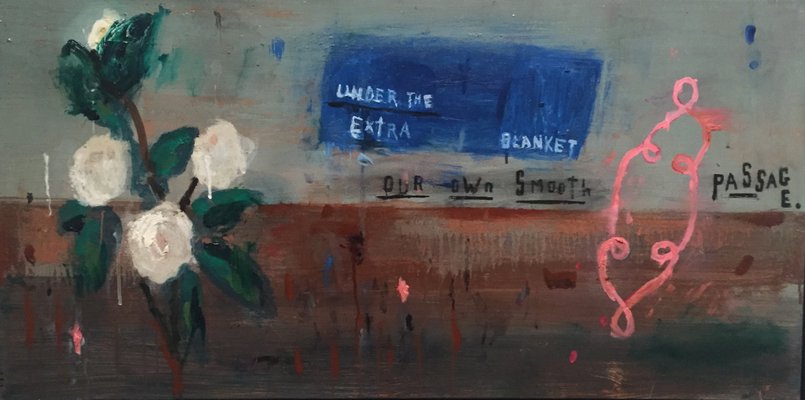
Although, superficially, the work of Stephanie Brody-Lederman at Guild Hall in East Hampton and Jim Gemake at the Peter Marcelle Project in Southampton are dramatically dissimilar, they share a remarkable trait: each could be described as a narrator whose storyline offers only a sliver of what is being imparted. As the philosopher and political theorist Hannah Arendt once noted: “Storytelling reveals meaning without committing the error of defining it.”
In Ms. Brody-Lederman’s works in the museum’s Spiga Gallery, the artist continues her painterly explorations that revolve around elementally simple imagery that, in their totality, develop deceptively compelling and complicated narratives. Titled “Dancing with Truffaut,” the exhibition pays homage to the late French New Wave filmmaker, whose movies—such as the charming, circa-1976 “Small Change”—focused on the ordinary and seemingly insignificant aspects of daily life, and how those apparently trivial moments define the characters themselves.
Using memory and history as a base from which the works evolve, Ms. Brody-Lederman creates tableaus that shimmer with a cinematic air of mystery that is both startlingly real, yet as illusory as a child’s apparition. This generates an atmosphere of gentle reverie underscored by her juxtaposition of imagery and phrases that float in surreal planes within the composition. The combination hints at hidden meaning, but only in the most understated manner. This permutation produces an ambiance that allows the viewer to conjure worlds imagined and existent, reminiscent of poet Djuna Barnes’s observation that dreams “have only the pigmentation of fact.”
In the work “It Began With My Dog” (oil and acrylic on canvas, 2014), the artist incorporates a number of images into a winter scene—three trees, a bird, a table, a couple of cherries, but no dog—all of which manage to appear to effortlessly float in space while, incongruously, seem completely grounded in different planes within the organizational construct of the canvas. Further hints at the artist’s intent abound, such as an incised phrase that reads, “And we do it over,” as well as an abstract color chart in the lower quadrant and, along the right portion of the picture plane, a stylized keyboard adds the hint of musical harmony to the trance-like imagery.
“High” (oil and acrylic on canvas, 2014), on the other hand, gives fewer component pieces within the composition, yet nevertheless offers a similar kind of narrative ambiguity. Using a delicately painted white bird to anchor the composition, the artist orchestrates the movement within the canvas using a horizontal pine branch that guides the viewer’s gaze, and adds elements suggestive of motifs found in traditional Japanese screen works, such as those by the 16th-century artist Hasegawa Tōhaku.
While Ms. Brody-Lederman approaches her use of imagery from a painterly perspective related to the Symbolists, Jim Gemake uses principles of constructivism to fashion his mixed-media works. In his exhibit at the Peter Marcelle Project in Southampton, “The Arrow in My Art,” the artist appropriates ideas from cubism and the Russian Suprematism and avant-garde to conjure narratives that seek to remove the viewer from the traditionally static role of “observer” and instead prompt an active intellectual relationship to the artwork itself.
Mr. Gemake accomplishes this, in no small part, due to his confidant ability to create internal dialogues within the works that, rather than merely convey traditional concepts of beauty or formal composition, instead utilize the form and physical properties of the juxtaposed objects to propel the aesthetic discussion. Further, by constantly evoking an interesting sense of whimsy through his manner of constructing the assemblages, as well as through his entertaining use of titles, the artist is able to engage the audience without completely dictating responses to the works.
In some cases, including assemblages “This End Up,” “Arc” and “Without a Shred of Evidence,” the physical configurations and the inventive use of materials drive the observer’s emotional reaction. In others, such as “A Vial (Vile) Existence” and “Keeping an Eye on Russia,” the impact derives from the audience’s relationship to works by well-known icons of 20th-century art—for example, Joseph Cornell and Alexander Rodchenko.
This latter point is particularly apparent in the “Tatlin’s Inner Circle,” which pays homage to sculptor Vladimir Tatlin. His unfinished tower, “Monument to the Third International,” with its dynamic use of sculptural diagonals, is considered the most important spur to the creation of the constructivist movement in early 20th-century Russia. Interestingly, in terms of the stated objective by the early Constructivists to make art more utilitarian, Tatlin’s next project was the design of a more functional stove.
“Dancing with Truffaut,” featuring paintings by Stephanie Brody-Lederman, will remain on view through January 3 at Guild Hall in East Hampton. Hours are 11 a.m. to 5 p.m. on Fridays, Saturdays and Mondays, and noon to 5 p.m. on Sundays. For more information, call (631) 324-0806, or visit guildhall.org.
“The Arrow in My Art,” featuring work by Jim Gemake, will remain on view through Sunday, November 15, at the Peter Marcelle Project in Southampton. Hours are 11 a.m. to 4 p.m. on Thursdays through Sundays, and by chance or appointment on Mondays through Wednesdays. For more information, call (631) 613-6170, or visit petermarcelleproject.com.